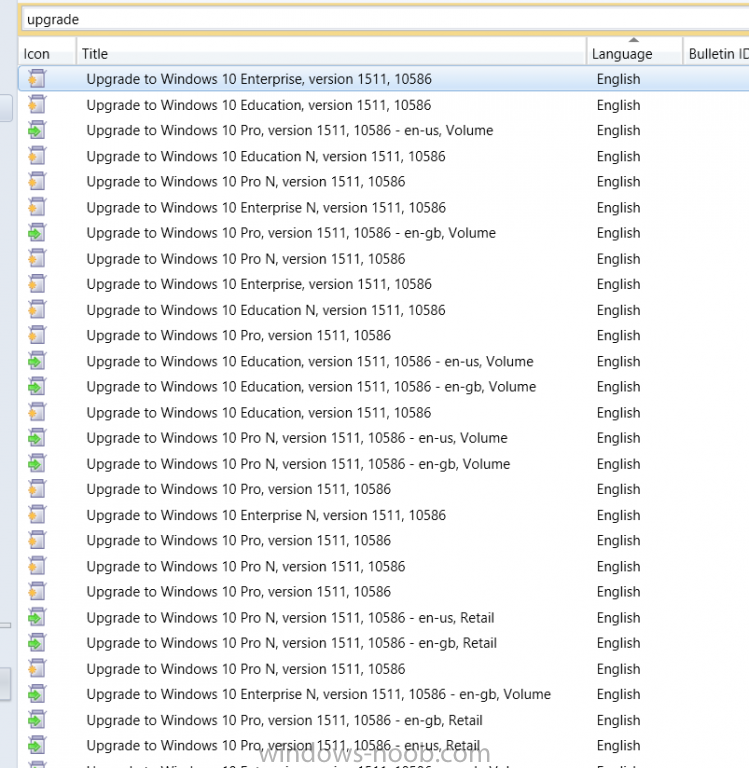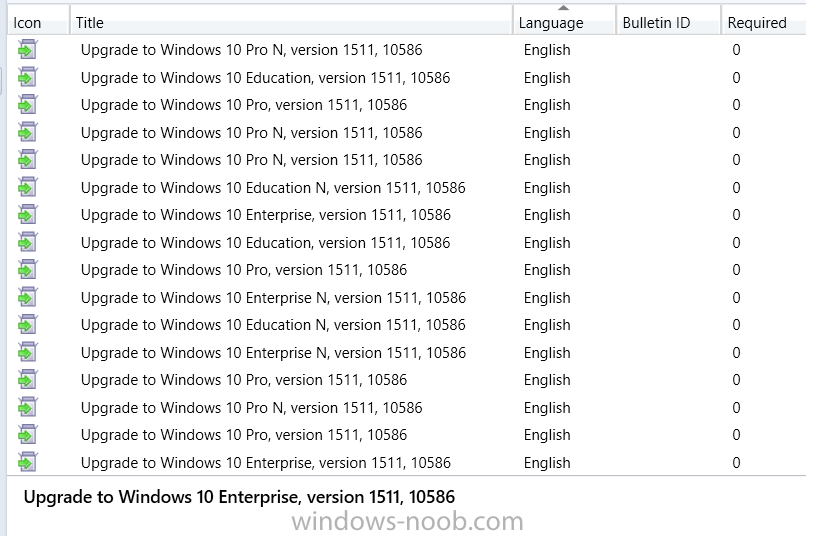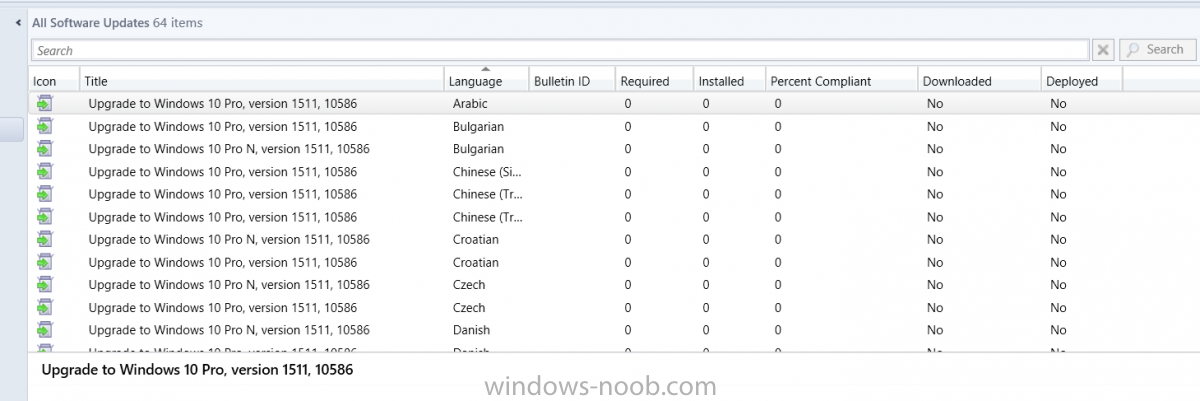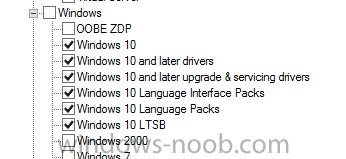
Siroj
Established Members-
Posts
29 -
Joined
-
Last visited
-
Days Won
2
Everything posted by Siroj
-
Hi guys. We are having discussions on what path we should follow regarding the in-place upgrades of the laptops from the personnel that is working from home. All those laptops are connected through direct access and we have upgraded most of the laptops to build v1709 using a regular TS. Major difference was that at the time the personnel were at the office most of the time so we could pre-cache all data to the laptop when they were there. Now that almost all of our 3000 personnel is working mostly from home, the "pre-cache at the office" is not a valid option anymore. Alternatively we could download all data for the in-place upgrade through direct access but that's not what we want. We are looking at how to cope with this now. Ideas are making use of a DP in CMG and get the required data from there. Or perhaps a DP in our DMZ could be an option. What i am looking for is how you are managing this, what path have you chosen?
-
Our Setup: - SCCM 1806 on Server 2016 - Clients are running Windows 10 1709 (about 25000 clients) - Clients running corresponding SCCM client v5.00.8692.1008 We are trying to utilize Peer Caching but are unsuccessful in getting it to work. After a number of tries to connect to a peer, it uses the DP as last resort and successfully downloads the data (but not from a peer cache source). We verified that firewall ports (8003, 8004) are opened at the source peer. We re-entered the NAA account info and successfully verified. For testing purposes we also granted full access rights to CCMCACHE folder to the NAA account In SMSTS.log we see that the client has located a peer, tried to connect but failed. Some possible relevant LOG entries: Does anyone have any idea where to look next?
-
Pop-Up from Windows Defender
Siroj replied to dozi's topic in System Center Configuration Manager (Current Branch)
Take a look at: http://ccmexec.com/2016/08/disabling-windows-defender-whats-new-in-windows-10-1607/ That should help you out! -
I know that it's possible to automatically set WinPE resolution by setting the X and YResolution variable when using MDT integration. Using an unsupported (low) value results in automatic detection. We want to incorporate the same solution, but without MDT integration. I can't find a solution to this, so my question is if this is even possible? I won't mind adding some custom variables or making other customization's.
-
We would like to create the following situation if possible: A new Windows 10 build/version is made available and is prepared by our technicians through SCCM. An upgrade TS is created and deployed to specific devices (laptops). When at work, an employee receives a notification through Software Center that an Upgrade Operating System (TS) is available. The employee selects the TS in Software Center. In the background all required components are downloaded/prestaged to disk and when ready the employee is presented with a message that the Upgrade is ready to be performed. At this stage it should be possible to go home or anywhere else and kickoff the upgrade, not having to be connected to the office network for the upgrade to complete. Is above scenario possible with current technology?
-
We are going to use SCCM to deploy Windows 10 v1607 to about 5000 devices. A script is written to detect the monitors resolution and copy a matching wallpaper to the device. What we want then is (preferably using GPO) to set this wallpaper as default to our users on first login and allow the user to change the wallpaper. We know we can set a fixed wallpaper using GPO, but that is not what we want/need in this case. If i use GPO Preferences to create the items Wallpaper and WallpaperStyle under [HKEY_CURRENT_USER\Control Panel\Desktop] and set it to only apply once, it gets overwritten with the default values while creating the profile after first login. So my question is, how can i set this wallpaper as default to our users on first login and allow the user to change the wallpaper?
-
We have a Windows 10 task sequence that uses a Apply Driver Package step. Drivers get installed correctly, as it seems when reviewing smsts.log. The correct package is applied. After the TS is complete, some devices have no driver installed. Now the weird stuff comes to play... When we wait a few seconds/minutes these missing drivers get installed automatically. The machine has no internet connection so the drivers have to be available to the OS. Why are these drivers installed after the TS is complete and not during the Driver installation step during the TS? And more important, how can we overcome this behavior?
-
The errors occur right after the sysprep phase and another time at the end of the TS. The network adapter used in the virtual machine is the generic E1000 and for what i was able to check, during WinPE and FullOS the adapter was having an IP address and was able to ping and resolve the FQDN. THe only thing i have to double check is if it looses it's netwerk connection during the prepare OS phase, the phase when the errors are written in the logs. I don't know if i am able to check the connection at this point and if i am fast enought to do so. Any tips on that? Is there any info on what's happening during the time the errors are logged, mainly things that could explain the loss of connection to the server/network? As it's a virtual environment in our ESX farm, there is no issues like waiting for Spanning Tree for example.
-
I am building a Windows 10 10586 reference image. The image builds without any noticeable faults and the captured .WIM file is available after the process is completed. When examining the smsts.log however, multiple 0x80072ee7 errors are present. All these errors occur after sysprep has been executed. I know this error is DNS/network related most of the time, but i have checked connectivity during all stages when possible and the connection is available, the FQDN is resolved and able to ping. All previous steps like installing software, installing configmgr client etc are processed without errors + the TS finishes without further errors. Any help is appreciated. Sample of error, smsts.log is attached with relevant section of log:
-
Issue is resolved. I have changed a couple of things so what fixed the issue is a bit of a guess but what i noticed was that Windows was being installed on drive X and partitioning was incorrect. For now i let Windows 10 install on a single 100% primary partition and i make use of the OSDPreserveDriveLetter variable.
-
I have a basic task sequence to capture a virtual (VMware ESX and/or Workstation) Windows 10 10586 reference machine with no applications or customization for testing purposes. The process completes successfully and .WIM file is available. After capturing the machine i reset the virtual machine to verify if installed machine is ok, but when rebooting it wont boot and is only showing the Windows logo and looping circle. Any idea?
-
At this moment we are in the process of creating a new Windows 10 image and all related stuff (TS, apps, etc) in our lab/test environment. This lab env is running SCCM Current Branch (1511). Our production env is running 2012 R2 and we are preparing and planning to upgrade this production env to the same level as our lab env. Both env are separate hierarchies with different site codes, but are member of the same domain and have full network connection. Data source of both env is stored on a central SAN that is available to both env. What we want is to be able to copy/export/migrate all relevant stuff from the lab env to our production env when this is fully tested and approved. It would be very nice if we would be able to accomplish this export from the newer Current Branch version into our production environment that is running an older version, but realistically i guess this is not supported nor possible and don't want to spend to much time into this scenario. What i do want to know is what's the best method of copying/exporting/migrating from our lab env to our production env? I know the existence of the TS export function and the migration tool, but have not tested both. Testing both is no problem, but i would like to know your experiences with this kind of setup. Any help/tips is greatly appreciated!
-
W10 Ent Upgrade to build 10586
Siroj replied to Siroj's topic in System Center Configuration Manager (Current Branch)
Bug is reported on Connect: https://connect.microsoft.com/ConfigurationManagervnext/Feedback/Details/2134832 -
W10 Ent Upgrade to build 10586
Siroj replied to Siroj's topic in System Center Configuration Manager (Current Branch)
New upgrade files appeared today with added "Volume" and "Retail" description, unfortunately still the same error when downloading. Patchdownloader.log shows the new entry refers to the same file as before. -
W10 Ent Upgrade to build 10586
Siroj replied to Siroj's topic in System Center Configuration Manager (Current Branch)
Just to rule out any leftovers from previous versions, on a secondary server i have installed a fresh standalone SCCM v1511 server with SQL and i am experiencing the exact same issue of not able to download the Enterprise upgrade files and same errors as above. -
W10 Ent Upgrade to build 10586
Siroj replied to Siroj's topic in System Center Configuration Manager (Current Branch)
Seems like MS released the Enterprise and Education upgrade files as these just showed up in my console Tried downloading the Enterprise upgrade file and this one also errors out: Trying to connect to the root\SMS namespace on the SCCM.test.local machine. Software Updates Patch Downloader 12/11/2015 9:35:58 AM 5492 (0x1574) Connected to \\SCCM.test.local\root\SMS Software Updates Patch Downloader 12/11/2015 9:35:58 AM 5492 (0x1574) Trying to connect to the \\SCCM.test.local\root\sms\site_TST namespace on the SCCM.test.local machine. Software Updates Patch Downloader 12/11/2015 9:35:58 AM 5492 (0x1574) Connected to \\SCCM.test.local\root\sms\site_TST Software Updates Patch Downloader 12/11/2015 9:35:58 AM 5492 (0x1574) Download destination = \\sccm\d$\Sources\Upgrades\ccaebb8a-baa2-438e-8e4a-810c46b45ca1.1\10586.0.151029-1700.th2_release_CLIENTENTERPRISE_VOL_x64fre_nl-nl.esd . Software Updates Patch Downloader 12/11/2015 9:35:58 AM 5492 (0x1574) Contentsource = http://wsus.ds.b1.download.windowsupdate.com/c/upgr/2015/12/10586.0.151029-1700.th2_release_cliententerprise_vol_x64fre_nl-nl_8a85077a24e073bbd1475f31b2b7e40d705b09d8.esd . Software Updates Patch Downloader 12/11/2015 9:35:58 AM 5492 (0x1574) Download destination = \\sccm\d$\Sources\Upgrades\ccaebb8a-baa2-438e-8e4a-810c46b45ca1.1\WindowsUpdateBox.exe . Software Updates Patch Downloader 12/11/2015 9:35:58 AM 5492 (0x1574) Contentsource = http://wsus.ds.b1.download.windowsupdate.com/c/updt/2015/11/windowsupdatebox_f994a5e24608d2839a4f2f9f800d1c8585881782.exe . Software Updates Patch Downloader 12/11/2015 9:35:58 AM 5492 (0x1574) Downloading content for ContentID = 16778372, FileName = 10586.0.151029-1700.th2_release_CLIENTENTERPRISE_VOL_x64fre_nl-nl.esd. Software Updates Patch Downloader 12/11/2015 9:35:58 AM 5492 (0x1574) Download http://wsus.ds.b1.download.windowsupdate.com/c/upgr/2015/12/10586.0.151029-1700.th2_release_cliententerprise_vol_x64fre_nl-nl_8a85077a24e073bbd1475f31b2b7e40d705b09d8.esd in progress: 10 percent complete Software Updates Patch Downloader 12/11/2015 9:36:37 AM 5440 (0x1540) Download http://wsus.ds.b1.download.windowsupdate.com/c/upgr/2015/12/10586.0.151029-1700.th2_release_cliententerprise_vol_x64fre_nl-nl_8a85077a24e073bbd1475f31b2b7e40d705b09d8.esd in progress: 20 percent complete Software Updates Patch Downloader 12/11/2015 9:37:12 AM 5440 (0x1540) Download http://wsus.ds.b1.download.windowsupdate.com/c/upgr/2015/12/10586.0.151029-1700.th2_release_cliententerprise_vol_x64fre_nl-nl_8a85077a24e073bbd1475f31b2b7e40d705b09d8.esd in progress: 30 percent complete Software Updates Patch Downloader 12/11/2015 9:37:35 AM 5440 (0x1540) Download http://wsus.ds.b1.download.windowsupdate.com/c/upgr/2015/12/10586.0.151029-1700.th2_release_cliententerprise_vol_x64fre_nl-nl_8a85077a24e073bbd1475f31b2b7e40d705b09d8.esd in progress: 40 percent complete Software Updates Patch Downloader 12/11/2015 9:38:00 AM 5440 (0x1540) Download http://wsus.ds.b1.download.windowsupdate.com/c/upgr/2015/12/10586.0.151029-1700.th2_release_cliententerprise_vol_x64fre_nl-nl_8a85077a24e073bbd1475f31b2b7e40d705b09d8.esd in progress: 50 percent complete Software Updates Patch Downloader 12/11/2015 9:38:31 AM 5440 (0x1540) Download http://wsus.ds.b1.download.windowsupdate.com/c/upgr/2015/12/10586.0.151029-1700.th2_release_cliententerprise_vol_x64fre_nl-nl_8a85077a24e073bbd1475f31b2b7e40d705b09d8.esd in progress: 60 percent complete Software Updates Patch Downloader 12/11/2015 9:39:04 AM 5440 (0x1540) Download http://wsus.ds.b1.download.windowsupdate.com/c/upgr/2015/12/10586.0.151029-1700.th2_release_cliententerprise_vol_x64fre_nl-nl_8a85077a24e073bbd1475f31b2b7e40d705b09d8.esd in progress: 70 percent complete Software Updates Patch Downloader 12/11/2015 9:39:31 AM 5440 (0x1540) Download http://wsus.ds.b1.download.windowsupdate.com/c/upgr/2015/12/10586.0.151029-1700.th2_release_cliententerprise_vol_x64fre_nl-nl_8a85077a24e073bbd1475f31b2b7e40d705b09d8.esd in progress: 80 percent complete Software Updates Patch Downloader 12/11/2015 9:40:00 AM 5440 (0x1540) Download http://wsus.ds.b1.download.windowsupdate.com/c/upgr/2015/12/10586.0.151029-1700.th2_release_cliententerprise_vol_x64fre_nl-nl_8a85077a24e073bbd1475f31b2b7e40d705b09d8.esd in progress: 90 percent complete Software Updates Patch Downloader 12/11/2015 9:40:28 AM 5440 (0x1540) Download http://wsus.ds.b1.download.windowsupdate.com/c/upgr/2015/12/10586.0.151029-1700.th2_release_cliententerprise_vol_x64fre_nl-nl_8a85077a24e073bbd1475f31b2b7e40d705b09d8.esd to D:\TEMP\CABA82A.tmp returns 0 Software Updates Patch Downloader 12/11/2015 9:40:53 AM 5440 (0x1540) Checking machine config Software Updates Patch Downloader 12/11/2015 9:40:53 AM 5440 (0x1540) Cert revocation check is disabled so cert revocation list will not be checked. Software Updates Patch Downloader 12/11/2015 9:40:53 AM 5440 (0x1540) To enable cert revocation check use: UpdDwnldCfg.exe /checkrevocation Software Updates Patch Downloader 12/11/2015 9:40:53 AM 5440 (0x1540) Authentication of file D:\TEMP\CABA82A.tmp failed, error 0x800b0004 Software Updates Patch Downloader 12/11/2015 9:40:53 AM 5440 (0x1540) ERROR: DownloadContentFiles() failed with hr=0x80073633 Software Updates Patch Downloader 12/11/2015 9:40:53 AM 5492 (0x1574) -
W10 Ent Upgrade to build 10586
Siroj replied to Siroj's topic in System Center Configuration Manager (Current Branch)
Thank you Brady for this info, i'll wait and see... Besides that, i am unable to open the page on Connect you posted. I am logged in and enrolled in the ConfigMgr customer feedback program. Error shows me that i am either looking for the wrong page or don't have read permissions. Any idea on that? Don't know if this is what you describe on Connect, but the Pro and Pro N edition upgrades fail to download on my test server and result in the following error: "Error: Failed to download content id 16777266. Error: Invalid certificate signature" PatchDownloader.log reads: "Authentication of ***.tmp failed, error 0x800b0004" "ERROR: DownloadContentFiles() failed with hr=0x80073633" Regular updates download just fine. -
We are running several Windows 10 Enterprise build 10240 machines that were deployed using 2012 R2 SP1 CU1 without problems. Now i am running a few of those 10240 W10 machines in a test environment where i have a sccm version 1511 server. What i want to test is the process of upgrading W10 10240 to 10586 (v1511). If i understand it correctly using the "latest and greatest" version of SCCM, i should be able to directly upgrade to 10586 without using task sequence and/or reinstall just like installing a regular update. But after syncing Software Updates, only upgrades for Windows 10 Pro and Pro N are available. My question is, how do i upgrade my Windows 10 Enterprise machines using SCCM (v1511) to build 10586 (v1511) without using the .ISO? Or are the Enterprise upgrade files not available yet?
-
Yesterday Microsoft released a new WiFi driver for the Surface Pro 3 (15.68.3073.151). In this new driver they seem to have fixed the bugs that were causing us a lot of issues. Must do some further testing but first impressions look good. The new drivers are not available as a separate download yet, so i have extracted them from an updated machine and imported them in SCCM. The need to downgrade to the older version is no longer there it seems, but i still would like to know if there is a method of force installing an older version of a driver while a newer version is included in the install.wim (just for the sake of learning new stuff).
-
We are running into issues with our Surface Pro 3 devices and our WiFi network. For whatever reason the combination of our Cisco devices, the use of 5Ghz band and the latest/default driver version 15.68.3091.193 isn't working well. For us, a solution for now is to use an older driver version (15.68.3073.151). Using that version we have no problems what so ever. The problem we have is that the 3091.193 version driver is a default driver in the install.wim file of Windows 10. Using SCCM to apply a driver package containing the older driver doesn't work as the driver inside the install.wim is used. Also deleting the driver from the install.wim using DISM is not supported: Does anyone have a supported method of forcing the installation of an older driver version? Any help is appreciated! Edit: Forgot to mention we are using SCCM 2012 R2 SP1 CU1 with all hotfixes. OS we are deploying is Windows 10.
-
Have been searching for a while now but i am unable find an explanation for the Windows 10 products that are available through Software Update Point (WSUS). What can i expect from those products, whats in it, when should i use them etc..? Can someone explain them to me or point to a good reference document/URL? Thanks!
-
Drivers not installing during TS deployment
Siroj replied to Siroj's topic in Configuration Manager 2012
One additional question: our Surface Pro 3 driver package includes all recent drivers and firmware. When applying the driver package in our TS, does this also automatically install all applicable firmware updates? -
Drivers not installing during TS deployment
Siroj replied to Siroj's topic in Configuration Manager 2012
Using the package seems to fix the problem. Just imaged a Surface Pro 3 and all drivers installed nicely! Still wondering why the Apply Driver step doesn't work for Windows 10..?..






